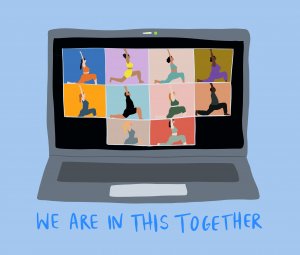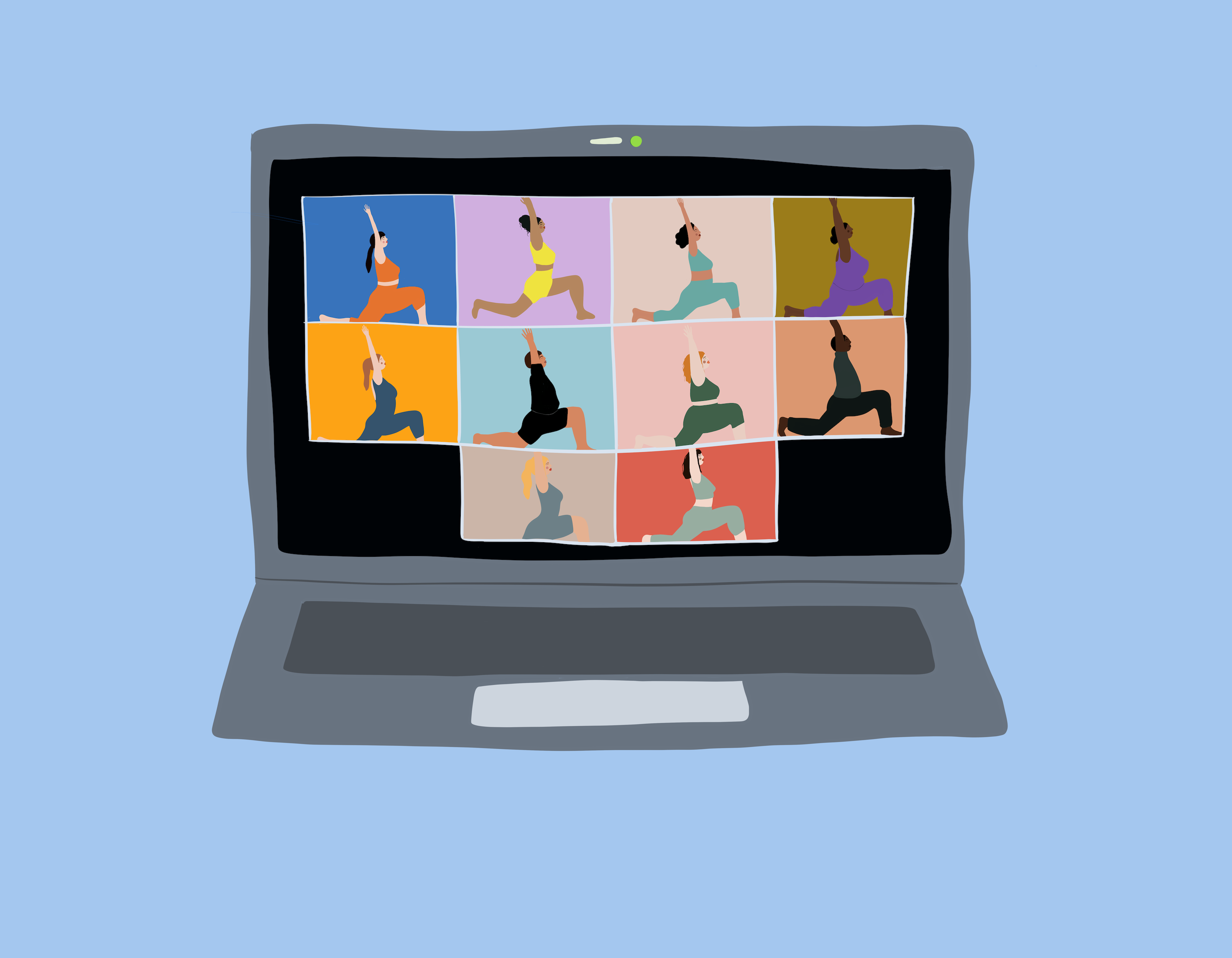Since the beginning of the lockdown, my opinion of the digital yoga world has shifted dramatically. Like many other freelancers and yoga teachers, I found myself confused and unemployed. It seemed that the only way forward was to start teaching online.
I’ve never wanted to teach yoga online. The idea of it made me anxious and embarrassed; I didn’t feel I was good enough for the task. It also seemed that every yoga and fitness teacher out there was taking their classes online with the hope of making a little income or at least keeping up their routine and doing what they love. Overwhelmed, I wasn’t sure where to begin.
After much research and self pep talks, I started my online teaching journey. It was nerve-wracking to get in front of the camera for the first time, but I’m happy I did. It’s keeping me sane, happy, grounded, and connected to the community more than ever. The anxiety and fear I had around teaching in front of the screen are now gone. More importantly, I’m glad I’m able to teach again.
Here are some of the mindset shifts and reminders that have helped me to take the leap:
1. Teach live classes rather than pre-recorded ones
Online pre-recorded classes can be great, but it’s easy to slack, pause, and get distracted. People who love practicing at yoga studios with others will be on the lookout for a similar experience, and live stream classes on social media or platforms like Zoom are as good as it gets right now. They create a sense of community, and curious students get to practice with yogis and teachers from all around the globe.
2. Think about the people who now have access to your classes
Have you ever wished your friend from another country could come to your classes? Well, now they can! You can bring everyone together through your online offerings and connect with people you’ve never even met. Isn’t that wonderful?
3. Your students miss you!
Trust and believe in yourself. I don’t know how many of us need to hear this right now – you are enough. Your regular students miss you; they love your class, your teaching style, and your personality. I know that all the content already available online can be a bit intimidating, and it can make you feel like your input will go unnoticed. You might be thinking, “Why bother?” Remember that you have unique assets that make you you, and the right people will come to you for who you are as a teacher and as a human. Your students and friends will be more supportive than you think!
4. It’s a lot easier than you think
You don’t need any fancy or expensive equipment to do your live class; a laptop or phone will be enough. Do some test classes first, figure out which platforms work best for you, and try out different ways of filming yourself. It won’t be perfect the first time, and it doesn’t need to be. It’ll get easier, I promise! You have all the time in the world to figure this out right now, so give it a try, and start sharing your practice with others online when you feel ready.
I had all these fears and worries about teaching online, but it’s been wonderful to connect and practice with people from all over the world.
Zoom has worked well for me and many others, but there are plenty of alternatives such as Skype, Google hangout, Instagram live, Facebook live, and so on. There are pros and cons to using Zoom to teach your classes. When the whole globe suddenly started using the platform for yoga classes and casual meetups, there was a lot of controversy about their lack of security and data protection. The company has, however, recently implemented extra security measures for all meetings (like the ability to enable a waiting room, create a password for a meeting, or lock the room once everyone is there), and they are still working on making the platform safe.

What I like about teaching on Zoom is that you can see your students, and they can see each other if they wish to, unlike when you do a live stream on IG or Facebook. My students said that it felt like being in the room together, connecting, moving, breathing, and practicing with other Yogis at the same time.
I use my iPhone camera to film with Zoom on a cheap tripod I bought online, then I sign in into Zoom again from my laptop. I keep it near me so I can see my students, and it works wonderfully.
I also make playlists for my classes and send them out, so students can play them during the class if they wish to. You can ask people to mute their microphones until the end so there are no distractions (highly recommended, there’s a setting that allows you to mute all participants on entry). If the iPhone and laptop combination sounds too complicated, you can most definitely just use your laptop inbuilt webcam and microphone.

How I promote my online classes
When I started to plan my first online class, I personally reached out to all the students that follow me on social media, and to friends and family. I asked them if they would be interested in joining my first online class and the response was overwhelmingly positive. I don’t have a massive following on Instagram, and I don’t have a yoga Facebook page, but I used the resources and contacts that I had within my reach. To my surprise, students and friends started to recommend and promote my classes on their socials. My first class was by far the busiest I’ve had, but after that, the numbers have been pretty consistent. I’m London- based, but I’ve also had people joining me from New York, Spain, Italy, all by word of mouth.
Pricing
My classes are donation-based, but I encourage people to join for free if they can’t afford to pay right now. It’s creating a lovely sense of community, and it makes me so happy to get messages of gratitude from students.
Scheduling
A lot of people are working from home 9-5 right now. Having a reason and actual commitment to get up and move matter a lot to those stuck at their desks all day. This is why I made my schedule in accordance with what works best for the majority of my students.
Downsides of Teaching Online
Are there any downsides to teaching online? Of course. It’s never going to feel like the real thing, and technology can sometimes fail you. In a typical class, I would teach mostly by talking and observing my students. I pace around and only demo certain things, but online, it’s a bit different. Now, I have mixed groups of “regulars” and people who are new to yoga, and you can see the look of confusion on some faces when you cue certain things only verbally. Some students have their camera off, and there’s only so much you can observe on your laptop screen. When you teach a live class on IG live or Facebook, you can’t see the embodiment of your words, and it’s easier to get lost or lose tempo.
Whichever platform you opt for, you will have to be very articulate and accurate with your cues, demonstrate pretty much everything throughout the class, and remember to breathe! You are going to know exactly what your students experience when they practice your flows, and you might even get to see how hard some of your flows are. If you’re mostly a yang teacher, be ready to work! I often end up cueing an extra child’s pose to catch my breath.
If you’re a yin teacher, then it’s mostly good news. You will find that most people don’t have bolsters and yoga blocks at home but fear not! Ask students to use whatever they have at home – cushions, books, belts, a wall, the couch, even a can of beans can serve as a block.

I feel very grateful and happy I can still teach. Teaching online has given me back my sense of purpose and direction. It fills me with joy and happiness to receive messages from my students telling me how good they feel after the class and how happy they are that we can still practice together, especially during times when we need it more than ever.
Practical resources that helped me to get started
This is the most comprehensive and straightforward video I found that explains how to use your phone and laptop using Zoom.
Technical Tips; How to Teach Yoga on Zoom
This is a more extensive video on the same subject with even more tips about setting up and teaching online with Zoom.
There’s a private Facebook group called Yoga Teachers that has over 30k members. There have been a lot of posts about the challenges of teaching and using Zoom. It’s useful to join the group if you ever want to ask any Yoga related questions, and you can search and come back to the topics already discussed.
Seeing people sharing the same concerns about teaching online in this group made me realise I wasn’t alone. It’s what got my research started in the right direction and what eventually inspired me to write this article.
What has helped you start teaching online? How has it helped you stay grounded during these weird times? Share your experience with us!

Illustration by Harmony Willow Art | instagram.com/harmonywillowart
Edited by Ely Bakouche





